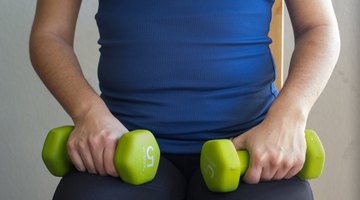Do's and Don'ts for Inner Thigh Exercises During Pregnancy
In the not-so-distant past, exercise during pregnancy was thought to be dangerous to mom and baby -- definitely not worth the risk of keeping a few unnecessary pounds off.
Times have changed, however, and OBs and midwives alike are encouraging expecting women to participate in a regular exercise program throughout pregnancy. While it is generally considered safe, there are a few things to consider when exercising during pregnancy, particularly when performing inner thigh exercises.
Do start early. If you think you want to exercise during pregnancy, begin as early as possible, preferably before you conceive. If you're already pregnant and want to become more active, exercise can be initiated during pregnancy if you are smart about it. The American Pregnancy Association recommends you start very slowly and avoid overexerting yourself. Inner thigh exercises that use only your body weight as resistance are a good place to start.
Don't perform inner thigh exercises that require a high level of balance. As your belly grows, your center of gravity changes and balance issues may result. Hold onto a sturdy object such as a counter or wall when performing inner thigh exercises in the standing position, such as gate swings or standing leg lifts.
Do exercise regularly. The only way to get results is to perform inner thigh exercises on a regular basis. Exercises can safely be performed two to four times per week with at least 48 hours between exercise sessions. Regular exercise is also less stressful for your baby than sporadic exercise sessions.
Don't ignore pain or discomfort during exercise. During pregnancy, your body releases hormones that increase the laxity in the parts of your body worked by inner thigh exercises, particularly your hips and pelvis, putting you at greater risk for injury in these areas. Symphysis pubis dysfunction is a condition common among pregnant women in which the ligaments that hold the pubic bone together become stretched. This results in an unstable pelvic joint and, often times, moderate to severe pain. Inner thigh exercises may exacerbate this condition and should be avoided if you suspect you're suffering from SPD.
Don't perform inner thigh exercises that require you to lie on your back after your first trimester. The weight of your uterus and baby can press against blood vessels, restricting blood flow to you and your baby.
Tips
Consult your OB or midwife to ensure you and your baby are healthy enough to continue exercise. Engage in a five to 10-minute warm-up prior to your inner thigh workout to ensure your body is prepared for exercise. Your warmup can include walking, marching in place or any other activity that gradually increases your heart rate.
Warnings
If you experience dizziness, chest pain, muscle weakness or bleeding stop exercise immediately and seek medical attention.
Related Articles
- PregMed.org: Symphysis Pubis Dysfunction (SPD)
- American Pregnancy Association: Pregnancy Exercise Guidelines
- American Council on Exercise Pre- and Post-natal Fitness; Lenita Anthony
- Shape: Top 10 NEW Exercises for Thinner Thighs










